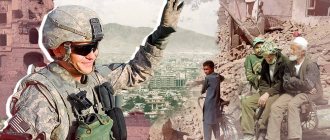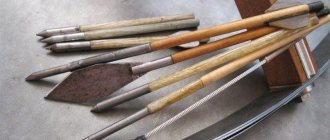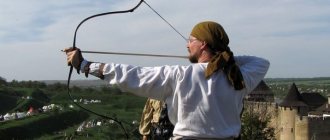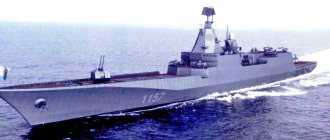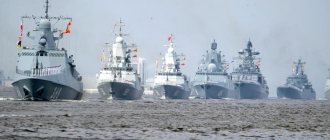What are the symbols of power in Russia?
The standard is a square panel of three equal-sized horizontal stripes of white, blue and red. It depicts the coat of arms of Russia, and the panel itself is bordered with gold fringe. On the shaft of the standard, which is crowned with a metal spear-shaped pommel, there is a silver bracket with the name of the president and the dates of his tenure in office engraved on it. The standard is in the office of the head of state in the Kremlin. Duplicates of the standard are raised over his residence in Moscow and over other residences if the president is there. The same standards are installed on his vehicles.
Badge of the President of Russia. Photo: Public Domain
The President's badge consists of the badge itself and the chain. The badge is made of gold and is an equal-armed cross with flared ends, the front side of which is covered with ruby enamel. In the center of the cross there is an applied image of the state emblem of the Russian Federation, on the reverse side there is a round medallion with the motto “Benefit, honor and glory.” The chain is made of gold, silver and enamel. It has 17 links, 8 of which are round in shape with the same motto as on the medallion, and 9 are in the form of a coat of arms. On the reverse side of the links there are overlays made of white enamel; the last name, first name and patronymic of each president and the year of his assumption of office for each term are engraved on them in gold.
Special copy of the Constitution of the Russian Federation. Photo: kremlin.ru
A special copy of the Constitution of the Russian Federation, bound in red monitor lizard leather, with an applied silver coat of arms of the Russian Federation and an embossed gold inscription “Constitution of the Russian Federation” was made on the eve of Boris Yeltsin’s re-assuming the presidency. An official description of this symbol has never been established. Before his first inauguration, Vladimir Putin revoked the status of a special copy of the Constitution as the official symbol of presidential power. However, according to tradition, all Russian leaders swore an oath on this copy of the fundamental law.
Order - His Excellency
In world practice, many different signs and objects are used as symbols of supreme power. For example, the President of France, upon taking office, accepts the chain of the Grand Master of the Legion of Honor. Just as in France, the Order of the Republic of Côte d'Ivoire (a former French colony) is transferred to the new president. This order itself is very similar in appearance to the Order of the Legion of Honor. There are similar presidential badges in some Latin American : the Medal of the President of Bolivia , the Order of the Liberator in Venezuela . But the most common symbol of power in Latin American countries is the presidential belt. It is made of cloth and is usually worn over the right shoulder to the left side of the hip. Presidential sashes are very bright and resemble national flags in color.
Mace of the President of Ukraine. Photo: Public Domain
Presidential badges also exist in many republics of the former USSR: Ukraine , Moldova, Kyrgyzstan and others. As a rule, they are made of precious metals and are often decorated with precious stones. The most original of Ukrainian presidential symbols is the mace. It is made of gilded silver and decorated with decorative patterns and precious stones, and consists of a handle and a spherical pommel. In addition to the fact that the mace is a striking weapon in itself, it also contains a stiletto with the Latin motto “Omnia revertutur” (“Everything returns”) engraved on its blade. The symbolic meaning of this phrase has been interpreted in different ways.
In some countries, very unexpected things can be symbols of presidential power. For example, a fly swatter is an extremely useful item in hot countries. The first President of Kenya, Jomo Kenyatta, always carried a fly swatter with him on special occasions, which served as a regalia, a symbol of his power. Malawian President Hastings Banda treated the fly swatter with the same reverent respect
With or without rights. Such different constitutions of the world Read more
Secrets of the Ukrainian trident. Khazar Kaganate and the “world government”
There are many versions of the meaning and origin of the “strange symbol,” as historians used to call it.
One of them is in this material.
Sfendoslav
“The coat of arms has serious semantic problems”: social networks about the new Ukrainian heraldry
©
Facebook, Alexander Tkachenko
Let's start from afar - with a man who was definitely involved in the appearance of a trident on his son's coins.
And he knew exactly what it meant. Sfendoslav - this is what the Byzantine emperors called the man whom we all know as Prince Svyatoslav Igorevich. It was Prince Svyatoslav who defeated Khazaria. Prince Svyatoslav is the father of Prince Vladimir, whose coins depict the now famous trident, which has become a symbol of modern Ukraine. Who was Svyatoslav's nationality? What did he use to cross the rapids of the Dnieper?
Why didn't you accept Christianity? How did he defeat Khazaria and did he defeat it?
© Public domain
Monument to Svyatoslav in Zaporozhye
Cursed Voracious
Until now, in the biography of Prince Svyatoslav, the son of Prince Igor and the holy Equal-to-the-Apostles Princess Olga, there are many inaccuracies and fabrications. This even applies to the well-known place of his death. In many official publications (even on Wikipedia) it is written that Prince Svyatoslav Igorevich, returning from the Bulgarian campaign to Kyiv, died near the island of Khortitsa in a battle with the Pechenegs.
Prince Svyatoslav actually died in a battle with the Pechenegs, but not in the area of the island of Khortitsa, but near one of the largest rapids on the Dnieper, Nenasytets. This happened in 972. Now in this area there is the village of Nikolskoye-on-Dnieper, and a memorial plaque has been installed in memory of this event. It was there that the governor Sveneld (the governor of his father, Prince Igor) said to the stubborn Svyatoslav: “Circle, prince, the rapids on horseback.” But the prince decided to go up the Dnieper. It didn’t work out - the Pechenegs were waiting on the doorsteps.
Spent the winter there. But he died in an attempt to cross the Insatiate in a battle with the Pecheneg prince Kurei. Then, as everyone knows, Kurya made a cup from his skull and drank from it. What did the Pechenegs drink there? Kumis?
This can be learned from their supposed ethnic descendants - the Bashkirs and Gagauzes. The warlike nomadic people did not leave written evidence, but it is known that the basis of the Pechenegs’ diet was cereals boiled in milk.
© Public domain
Chorikov B. A. The death of Svyatoslav.
Khortytsia
The version about Khortytsia arose, apparently, due to the fact that a monument by the sculptor Vyacheslav Klykov . In 2005, in honor of the 1040th anniversary of Svyatoslav’s victory over the Khazars, two monuments were erected. One is in the Belgorod region, the other is in Zaporozhye. And both sparked controversy and protests. The Federation of Jewish Communities of Russia opposed the installation of the monument in Belgorod. On the shield with which the Khazars defeated by the prince are covered, the sculptor (the same Vyacheslav Klykov) depicted the Star of David. As a result, the monument was erected not in the city, but in the Belgorod region. The Star of David disappeared from the shield.
And the local branch of the Prosvita society, Rodnovers and other concerned comrades spoke out against the Zaporizhzhya monument. Some did not like the fact that Svyatoslav was holding the sword as if “defeated” - according to the sculptor’s plan, the prince would pass the sword on to his descendants. The latter were dissatisfied with the fact that Svyatoslav held the sword like a cross. It is known that he was a pagan and refused to be baptized. “The squad will laugh at me,” he politely refused to his mother, Princess Olga.
Cossack on the throne
Mikhail Grushevsky called Prince Svyatoslav .
But who was really the prince by nationality? His mother, Olga, may have been of Varangian origin. Could be from a Slavic family. And she could have been from a Bulgarian family (a version very common in Bulgarian historiography).
There is also a version that Olga was the daughter of Prophetic Oleg, the mentor and regent of Prince Igor. And the Prophetic Oleg was the brother of the wife of Rurik , Igor’s father (also one of the versions). That is, Prophetic Oleg is Prince Igor’s uncle, and Olga is his cousin. Whether they were Varangians, Slavs or Scandinavians - this has been the subject of many years of debate that will never end. There is no exact information.
But the fact that Svyatoslav had nothing to do with the Cossacks is certain. Grushevsky uses a beautiful image, trying to metaphorically connect the warlike prince of the Rus and the Zaporozhye army.
Most likely, based on many signs, Svyatoslav would have recognized his opponents, the Pechenegs, in the Zaporozhye army. The Pechenegs also led a semi-nomadic lifestyle, their style of military operations was a sudden, quick raid, they constantly changed allies, they had contempt for treaties, and they had practically no statehood.
The son of Archon Ingor and Archon Elga (as the Emperor of Byzantium Constantine Porphyrogenitus ), Sfendoslav, would be very surprised at such an impartial comparison for him. And, perhaps, he would send the “historian” on a trip to row the monoxy with oars.
Who are monoxyls
It's not who, but what. Light single-tree vessels (in fact, in Greek the word “monoxyl” means “one tree”). Of course, it was not like the canoes of the Indians of North America or the dugout boats of the Evenks. The ships on which the Rus reached Constantinople should have been more powerful. As they say, in order to land troops and carry away the spoils. The Russians called them rooks and plows, the Greeks called them monoxyls.
“Let it be known that the monoxyls coming from outer Russia to Constantinople are some from Nemogard, in which Sfendoslav, the son of Ingor, Archon of Russia, sat...” said Constantine Porphyrogenitus.
Light ships with a flat bottom could move at sea, on a river, and on land (by dragging, or wooden wheels were attached to them for this purpose). Something similar to this monoxyl is depicted in Vasily Surikov’s “Stepan Razin”. These river-sea type vessels were not very beautiful, not very fast, but they were ideal for military trade campaigns “from the Varangians to the Greeks.” On these ships it was impossible to sail directly across the sea, as the Greeks themselves sailed. From the Bosphorus in a straight line to Chersonesos. "Monoxyls" walked along the coast, sometimes they were thrown onto land. But these ships did not cause ridicule among the Greeks. On the contrary, Byzantium was afraid of the warlike Rus in their monoxyls.
© Public domain
By the way, this is exactly how Princess Olga arrived in Byzantium at one time. Incredible woman! Get into some kind of boat and go through all the rapids of the Dnieper, across the Black Sea to Constantinople!
Khazaria - the country of the Jews
The most famous “act” of Svyatoslav is the defeat of Khazaria. He continued the work of his grandfather, Prophetic Oleg. "Took revenge on the foolish Khazars."
Many believe that this country was of the Jewish religion. This misconception led to the appearance of an ancient Jewish symbol - the Star of David - on the Klykov monument.
The record for the largest trident made of wood was broken in Transcarpathia
©
screenshot of the video TV company M-studio
But the inhabitants of the Khazar Kaganate, a huge state of the 8th - 10th centuries, were predominantly pagans.
Khazaria controlled the Volga, the Caspian Sea, Crimea, the Black Sea region, and the North Caucasus. This state profited from international trade - mainly along the Volga. And, importantly, it received tribute from the Slavic tribes. After the defeat of Khazaria, Russian princes began to receive this tribute. Even the assessment of what Khazaria was is still a matter of scientific debate. Was it a semi-nomadic predatory union of various clans or a state that was super-developed for its time (a version that became popular after the research of Lev Gumilyov). In any case, the defeat of the “unreasonable Khazars” was the most important moment in strengthening the power of the Russian princes.
© commons.wikimedia.org,
Khazar Khaganate
The main god of the Khazars is the sky god Tengri. There were both Christian and Islamic communities in the state.
However, the ruling elite of Khazaria itself actually changed its faith twice. Once they accepted Islam, the second time they accepted Judaism (it is believed that either under the influence of Jewish merchants, or under the influence of one of the Kagans, Obadiah, whose mother was a Jew).
By the time of Svyatoslav’s campaign, the Khazar Khaganate had weakened. The reason is internal civil wars, the struggle for power. Possibly religious disputes.
Contrary to popular belief, Khazaria did not cease to exist after Svyatoslav’s victory. The Kagan, the court, the nobility and many residents of the capital waited out the attack of the Rus on the islands in the Caspian Sea.
The history of Khazaria continued, they converted to Islam. But they gradually weakened, and eventually the Kaganate disappeared.
And after the victory, Svyatoslav took the trading elite of the Khazar state to Kyiv and settled the merchants there with honor and comfort. They now have their own quarter in Kyiv. By origin they were Khazars and Jews, and by religion they were Jews. It is believed that the Kozar tract in Kyiv, near the confluence of the Pochaina River with the Dnieper, was the place of settlement of Khazar merchants. Well, we are finally approaching an issue that has been causing furious debate for 30 years.
Tamga
One of the most controversial issues in today's Ukrainian heraldry is what constitutes a “trident”? Is it possible that this is a Khazar tamga?
Tamga is a family sign, a mark that was placed on livestock and other property. This is a very common phenomenon among a large number of nations. Tamga lives on as a symbol even now. For example, the tamga of the Gerays, the ruling dynasty of the Crimean Khanate, is today used by the Crimean Tatars as a national symbol.
© RIA Novosti, Sergey Malgavko / Go to photobank
The Constitution of Ukraine says: “The main element of the large State Emblem of Ukraine is the Sign of the Princely Power of Vladimir the Great.”
In publications, the trident is called “an ancient sacred symbol”, “the state sign of the princely Rurik dynasty.” And, of course, there are some oddities - “the first mention of the trident is found in Plato’s description of the clothing of the kings of Atlantis.”
Since Plato’s Atlantis is a fictional country - a utopia, this does not add any confirmation of historical authenticity to the “sacred symbol”.
However, the “sign of the Rurik dynasty”, “Sign of the Princely Power” is the same fiction as the trident of Atlantis.
There was no “Princely State of Vladimir the Great”. This state was called Rus'. Or Russian land, or Russian Kaganate. And “Prince Vladimir” himself was actually called Kagan Vasily.
"Save, Lord, our kagan"
This is an inscription on the wall of the Hagia Sophia in Kyiv. It is believed that the relatives of Prince Svyatoslav Yaroslavich (reigned 1073 - 1076) are crying out to the Lord. Russian princes were called the title Kagan, or Khakan, both before the baptism of Rus' and after the baptism. Metropolitan Hilarion directly writes: “our great kagan Vladimir” (about Vladimir Svyatoslavovich), “our blessed kagan Yaroslav” (about Yaroslav Vladimirovich). The Metropolitan was the confessor of Prince Yaroslav. Not only the title, but also the names of the princes were different. After baptism, Vladimir became Vasily, and Yaroslav became George.
Byzantine emperors called Russian princes “archons.” The title "prince" came to Rus' from Bulgaria at the beginning of the 12th century. And “Prince Vladimir” would also be very surprised to learn how his, the great Kagan and Archon, is called by his not very grateful and distorted descendants.
Pagan trident
But let’s return to the “sign of the Princely Power”. There was no common symbol of the state at that time. Each prince had his own symbols. There was no common “dynasty sign”. Tridents and bidents were found on many things, bricks, coins. But this, of course, was not considered as a coat of arms. And there were generally no state emblems at that time.
It was a sign of ownership, something like a personal signature.
Why did Vladimir take this symbol for his money?
© commons.wikimedia.org, Vladimir Lobachev
We don't know the reasons for this. Historians suggest several. One of the most popular versions is the title “Kagan”, the sign of a two-tooth and a trident were borrowed by Svyatoslav, and then by his children and grandchildren as a sign that their power was equal to the Great Khazaria.
Both the two-tooth (among Svyatoslav and Yaropolk) and the trident (among Vladimir and other princes) were popular.
In general, there are very, very many versions.
One of them. The princes (Svyatoslav, Vladimir) were military leaders of one of the Khazar clans. Svyatoslav’s campaign “against the Khazars” is part of some kind of internal Khazar civil strife.
Or Vladimir used this sign as a pagan amulet. Yes, Vladimir converted to Orthodoxy and abandoned paganism. But this did not prevent him from abandoning some pagan customs.
Another version. The trident is a symbol of the fact that the prince now controls part of the Khazar state. It's like his property.
Kyiv and London disagree on the Ukrainian trident
©
RIA Novosti, Stringer / Go to photobank
According to academician Pyotr Tolochko , the trident was a common symbol of property. By the way, the coin depicts Vladimir himself wearing a Byzantine crown. Vladimir was not crowned. Therefore, his image in the crown is a “claim” to higher power, to the fact that he is equal to the emperor of Byzantium. Anna , had the same symbolic meaning .
The blue-eyed, fair-haired beauty Anna, nicknamed Rufa (Redhead), did not want to marry a “Rus” at all, but the emperor persuaded her. Vladimir captured the Byzantine Korsun in the Crimea (Chersonese) and threatened to march on Constantinople.
Thus, a marriage with Anna resolved the issue of the security of Byzantium and helped to obtain military assistance from the Rus. Anna had to agree. “I’m walking like crazy, it would be better for me to die here,” this is how the Byzantine princess herself perceived this marriage.
But she died in Kyiv, many years later. Perhaps princes Boris and Gleb are her sons. Mystical sign
“Mysterious sign” is what researchers called Vladimir’s trident for many years. There seems to be nothing mystical or mysterious about it. But many tamgas are truly mystical symbols, magical signs. At least partly they have such a semantic load. In addition, this symbol is the sign of an “eastern aristocrat.”
Tamga with a trident is a well-known attribute of the Mongolian clans, Volga Bulgaria, and Tuvan clans. Everywhere it means “being in a high-level public service.” This is an aristocrat, a military leader.
What did Prince Vladimir want to say with his coin? Why does he continue to consider himself an aristocrat of the Kaganate?
That he opposes himself to Byzantium as an independent ruler, and not a vassal, by putting a personal sign of ownership on the back of the coin, where he depicted himself in the Byzantine crown? Which was also a bit of a “challenge”.
Did he want to say that he was a great shaman (a sign very similar to a trident is often found in images of shamans). Or is tamga in this case a simple commercial sign? Most likely, it's all together. The trident is a “sign of ownership of an eastern aristocrat.” In the Golden Horde, bidents and tridents meant belonging to the ruling family. Among the Nogais, Kirghiz, and Bashkirs, bidents and tridents are referred to as “Khan’s tamga”, “Sultan’s tamga”.
The title of Kagan disappeared along with the “signs of Rurikovich.” Already in the 12th century, when “The Tale of Igor’s Campaign” was written, Russian princes were called princes. And tridents and bidents were replaced with Christian symbols.
Georgy Narbut and other masons
But how did the trident turn out to be a symbol of Ukraine? This is to a certain extent an accident. The Trident was drawn as a symbol of the UPR by artist Georgy Narbut. Approved by the head of the UPR Mikhail Grushevsky. Initially, Grushevsky proposed making the symbol “a golden plow on a blue background.” We considered such symbols as the golden lion (Lviv coat of arms), Archangel Michael (patron of Kyiv). But they settled on the trident.
© Public domain
UPR banknote
It remained a symbol of the state both under Hetman Pavlo Skoropadsky and under the heads of the Directory Vladimir Vinnychenko and Symon Petlyura .
Of course, there is also a “conspiracy” version.
This is a conspiracy of the “world government”, which thus asserts the vassal relationship of Ukraine to the Great Khazaria.
It doesn’t matter that Khazaria has not existed for more than 1000 years. There is Great Khazaria, personifying the power of the Khazar and Jewish merchants. Essentially a world government.
There is another version.
Masons Grushevsky and Kerensky
Almost all members of the Provisional Government, which “destroyed tsarism” in Russia in February - March 1917, were Freemasons. Kerensky himself was a Mason. In the years before the revolution, Kerensky made three trips to Kyiv and Kharkov (in 1913, 1915, 1916), where there were large Masonic lodges. Apparently, to coordinate the future seizure of power.
In fairness, it must be said that other, “real” Masons considered these lodges to be political circles, “para-Masonic” organizations. But for political purposes they were quite suitable.
Members of the Masonic lodges were Grushevsky himself, Skoropadsky, Petlyura and the author of the future coat of arms of the UPR Georgy Narbut, many members of the government - Prokopovich , Baron Steingel , Shulgin , the richest sugar factory Tereshchenko (Minister of Finance of the Provisional Government). All of them were members of the “Great East of the Peoples of Russia” lodge. Most likely, there was nothing “Masonic” about the trident symbol.
The heads of the UPR themselves were not some kind of “initiates of a high degree.” It really was a political circle. More like a parody of the Masonic lodge. Subsequently, in emigration, those of them who wanted to continue their “Masonic career” had to undergo initiation again.
Grushevsky remained in the USSR, continued his professorial career and later recalled his “Masonic past” with reluctance.
Curiosities of Barbados
In addition to Ukraine, the “sacred symbol” is used in the coat of arms of another state - the Republic of Barbados. Moreover, the color of the Barbadian flag also matches. A trident proudly sits on a blue and yellow background. The Barbadians themselves explain that this is a symbol of the god of the seas, Poseidon. Blue is the sea, yellow is the sand of their land.
Amazing coincidence!
Standard with swastika
In some countries, very exotic rituals are adopted when taking on a higher position. For example, Joe Biden , who often stammers, confuses his words and takes long pauses in public speeches, could hardly become the president of the Czech Republic. In this country, the very process of reading the oath of the elected head of state is strictly regulated. The Czech Constitution states that deviations from its text and stumbles during reading entail the cancellation of the election results.
There are also more original symbolic inauguration rituals. Let's say the current President of Mexico, Andreas Manuel Lopez Obrador, went through a ceremony that included ancient Indian traditions. During the inauguration, he was fumigated with the smoke of medicinal herbs, which, according to Indian beliefs, expel evil spirits and protect against bad intentions.
Union Jack or Jolly Roger? 10 questions about flags of different countries of the world Read more
Sometimes presidents change the very symbols of power. Thus, in 2007 in Argentina, at the insistence of the first female president, Cristina Kirchner, the presidential baton was somewhat shortened. In Italy, during the inauguration, the president lays his hand not only on the Constitution, but also on the Bible. One of the attributes of presidential power in Turkmenistan is a quiver of arrows. It symbolizes the unity of the people, prosperity and blessings on a good path.
There is also a European country where the swastika is officially used: Finland. The swastika can be seen in the upper corner of the Finnish presidential standard. It is yellow and is inscribed in the so-called Cross of Freedom. True, many Finns deny the connection between the Finnish swastika and the Nazi one. However, it was recently removed from the flags of the country's Air Force.
A little history
The first mention of the appearance of tribal settlements of the Scythians, called the great power by M. S. Grushevsky, dates back to the 4th–1st centuries. BC e. By the VII-VIII centuries. In the forest and steppe zone on the territory of modern Ukraine, the Polyans, Drevlyans, Volynians and other Slavic tribes appeared. It was they who became the basis of Kievan Rus, formed in the 9th-10th centuries.
Further, numerous independent principalities arose and disappeared on its territory. The strongest was Galicia-Volyn, which fell into decline after the death of Prince Daniil of Galicia in 1264. By the middle of the 14th century, almost all states were included in the stronger Russian and Grand Lithuanian Principalities. In addition, semi-independent Cossack settlements with the beginnings of statehood lived and developed.
The most famous and influential settlement was the Zaporozhye Sich. During the people's liberation war of 1648-1654, Hetman Bogdan Khmelnytsky agreed with the Tsar of Great Rus' on joint actions against the Polish-Lithuanian Commonwealth. The left bank went to Moscow, the rest remained with the Poles. Then there were several more divisions of Poland, which led to changes on the geographical map:
- in 1772, Austria took Eastern Galicia and Northern Bukovina;
- as a result of the hostilities of 1793-1795, Russia got the Right Bank and Volyn;
- in the 19th century, as a result of the development of the southern steppe territories, the area of Ukrainian regions increased by almost a third.
The First World War and two Russian revolutions led to the occupation of Western Ukraine by Poland, Northern Bukovina by Romania, and Transcarpathia by Czechoslovakia. By 1917-1918 There were 3 relatively independent states:
- UPR - Ukrainian People's Republic.
- WUNR - Western Ukrainian People's Republic.
- SSRU - Socialist Soviet Republic of Ukraine.
The latter became the predecessor of the Ukrainian Soviet Socialist Republic, which became part of the USSR in 1922. After numerous annexations of various regions at the end of the Soviet Union era in 1991, the country opened new chapters of autonomous existence.


